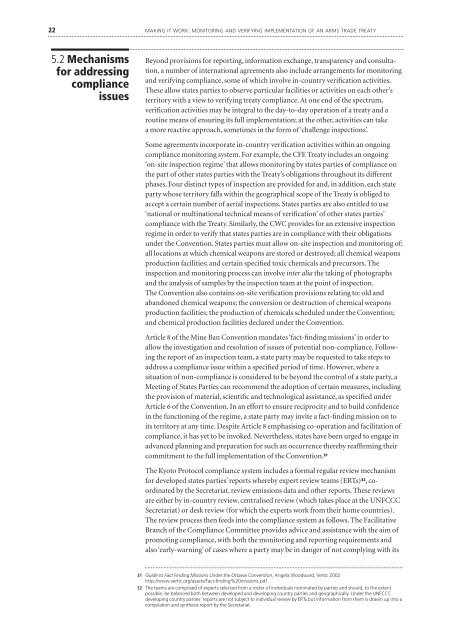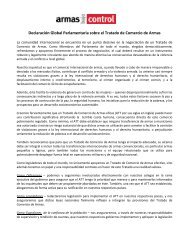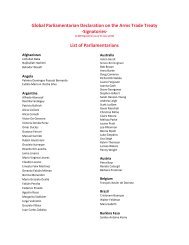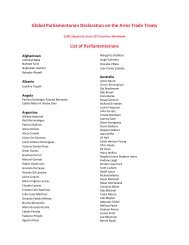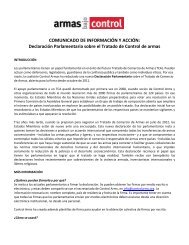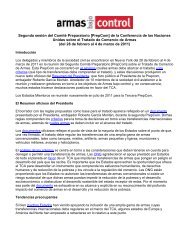Making it Work - Control Arms
Making it Work - Control Arms
Making it Work - Control Arms
- No tags were found...
You also want an ePaper? Increase the reach of your titles
YUMPU automatically turns print PDFs into web optimized ePapers that Google loves.
22 MAKING IT WORK: MONITORING AND VERIFYING IMPLEMENTATION OF AN ARMS TRADE TREATY5.2 Mechanismsfor addressingcomplianceissuesBeyond provisions for reporting, information exchange, transparency and consultation,a number of international agreements also include arrangements for mon<strong>it</strong>oringand verifying compliance, some of which involve in-country verification activ<strong>it</strong>ies.These allow states parties to observe particular facil<strong>it</strong>ies or activ<strong>it</strong>ies on each other’sterr<strong>it</strong>ory w<strong>it</strong>h a view to verifying treaty compliance. At one end of the spectrum,verification activ<strong>it</strong>ies may be integral to the day-to-day operation of a treaty and aroutine means of ensuring <strong>it</strong>s full implementation; at the other, activ<strong>it</strong>ies can takea more reactive approach, sometimes in the form of ‘challenge inspections’.Some agreements incorporate in-country verification activ<strong>it</strong>ies w<strong>it</strong>hin an ongoingcompliance mon<strong>it</strong>oring system. For example, the CFE Treaty includes an ongoing‘on-s<strong>it</strong>e inspection regime’ that allows mon<strong>it</strong>oring by states parties of compliance onthe part of other states parties w<strong>it</strong>h the Treaty’s obligations throughout <strong>it</strong>s differentphases. Four distinct types of inspection are provided for and, in add<strong>it</strong>ion, each stateparty whose terr<strong>it</strong>ory falls w<strong>it</strong>hin the geographical scope of the Treaty is obliged toaccept a certain number of aerial inspections. States parties are also ent<strong>it</strong>led to use‘national or multinational technical means of verification’ of other states parties’compliance w<strong>it</strong>h the Treaty. Similarly, the CWC provides for an extensive inspectionregime in order to verify that states parties are in compliance w<strong>it</strong>h their obligationsunder the Convention. States parties must allow on-s<strong>it</strong>e inspection and mon<strong>it</strong>oring of:all locations at which chemical weapons are stored or destroyed; all chemical weaponsproduction facil<strong>it</strong>ies; and certain specified toxic chemicals and precursors. Theinspection and mon<strong>it</strong>oring process can involve inter alia the taking of photographsand the analysis of samples by the inspection team at the point of inspection.The Convention also contains on-s<strong>it</strong>e verification provisions relating to: old andabandoned chemical weapons; the conversion or destruction of chemical weaponsproduction facil<strong>it</strong>ies; the production of chemicals scheduled under the Convention;and chemical production facil<strong>it</strong>ies declared under the Convention.Article 8 of the Mine Ban Convention mandates ‘fact-finding missions’ in order toallow the investigation and resolution of issues of potential non-compliance. Followingthe report of an inspection team, a state party may be requested to take steps toaddress a compliance issue w<strong>it</strong>hin a specified period of time. However, where as<strong>it</strong>uation of non-compliance is considered to be beyond the control of a state party, aMeeting of States Parties can recommend the adoption of certain measures, includingthe provision of material, scientific and technological assistance, as specified underArticle 6 of the Convention. In an effort to ensure reciproc<strong>it</strong>y and to build confidencein the functioning of the regime, a state party may inv<strong>it</strong>e a fact-finding mission on to<strong>it</strong>s terr<strong>it</strong>ory at any time. Desp<strong>it</strong>e Article 8 emphasising co-operation and facil<strong>it</strong>ation ofcompliance, <strong>it</strong> has yet to be invoked. Nevertheless, states have been urged to engage inadvanced planning and preparation for such an occurrence thereby reaffirming theircomm<strong>it</strong>ment to the full implementation of the Convention. 31The Kyoto Protocol compliance system includes a formal regular review mechanismfor developed states parties’ reports whereby expert review teams (ERTs) 32 , coordinatedby the Secretariat, review emissions data and other reports. These reviewsare e<strong>it</strong>her by in-country review, centralised review (which takes place at the UNFCCCSecretariat) or desk review (for which the experts work from their home countries).The review process then feeds into the compliance system as follows. The Facil<strong>it</strong>ativeBranch of the Compliance Comm<strong>it</strong>tee provides advice and assistance w<strong>it</strong>h the aim ofpromoting compliance, w<strong>it</strong>h both the mon<strong>it</strong>oring and reporting requirements andalso ‘early-warning’ of cases where a party may be in danger of not complying w<strong>it</strong>h <strong>it</strong>s31 Guide to Fact Finding Missions Under the Ottawa Convention, Angela Woodward, Vertic 2002http://www.vertic.org/assets/Fact-finding%20missions.pdf32 The teams are composed of experts selected from a roster of individuals nominated by parties and should, to the extentpossible, be balanced both between developed and developing country parties and geographically. Under the UNFCCCdeveloping country parties’ reports are not subject to individual review by ERTs but information from them is drawn up into acompilation and synthesis report by the Secretariat.


